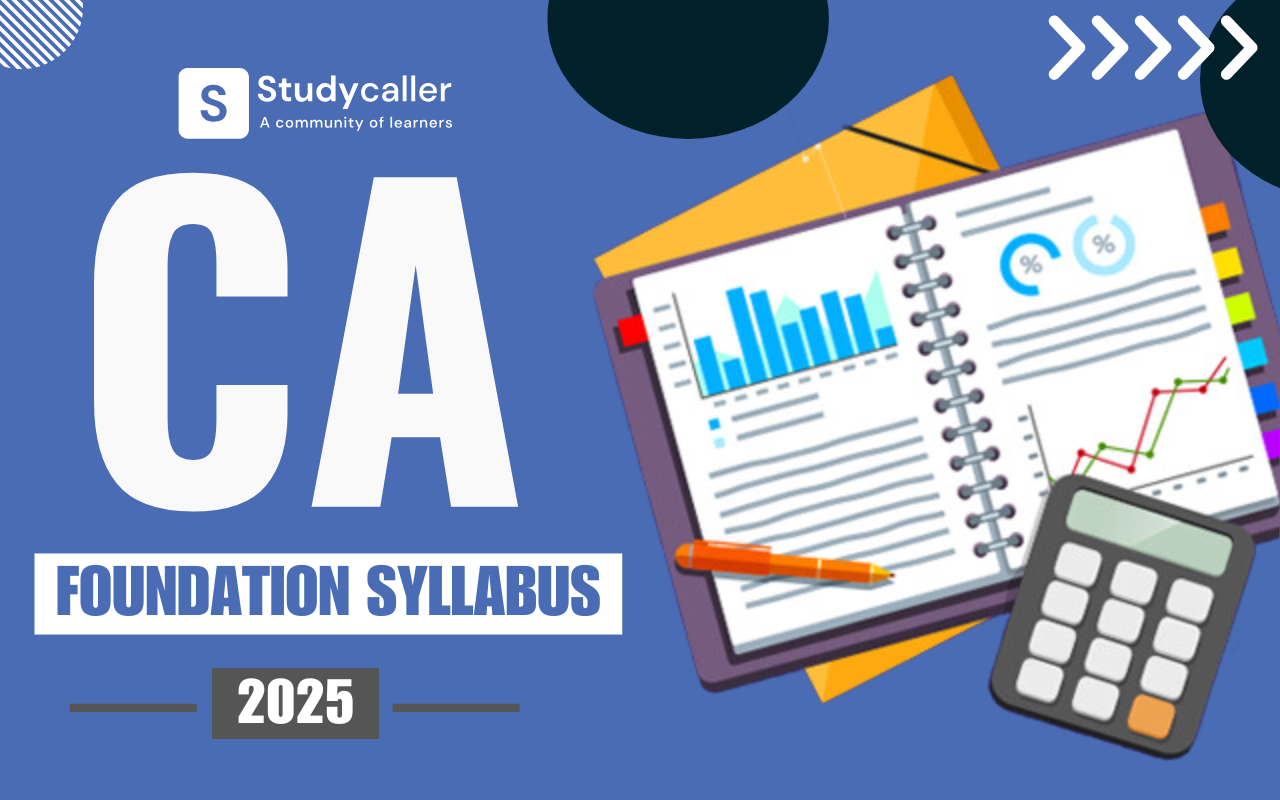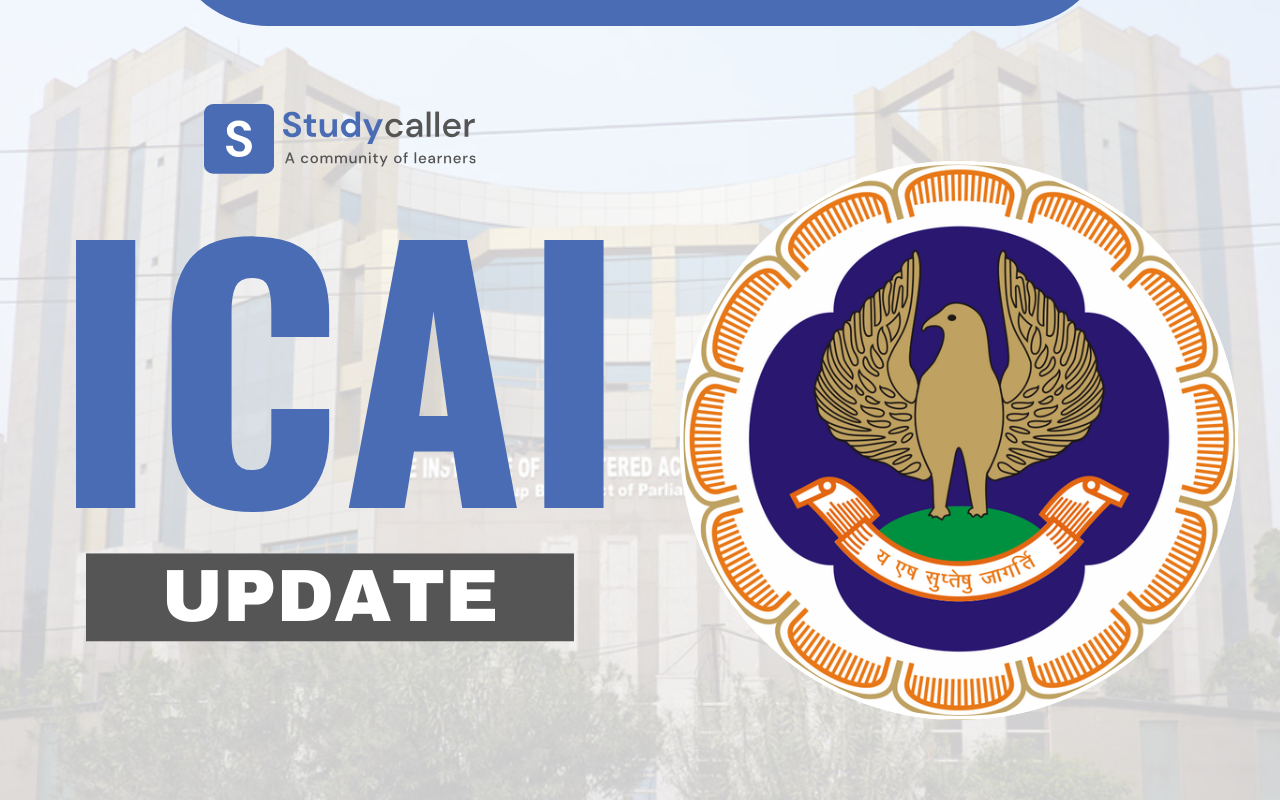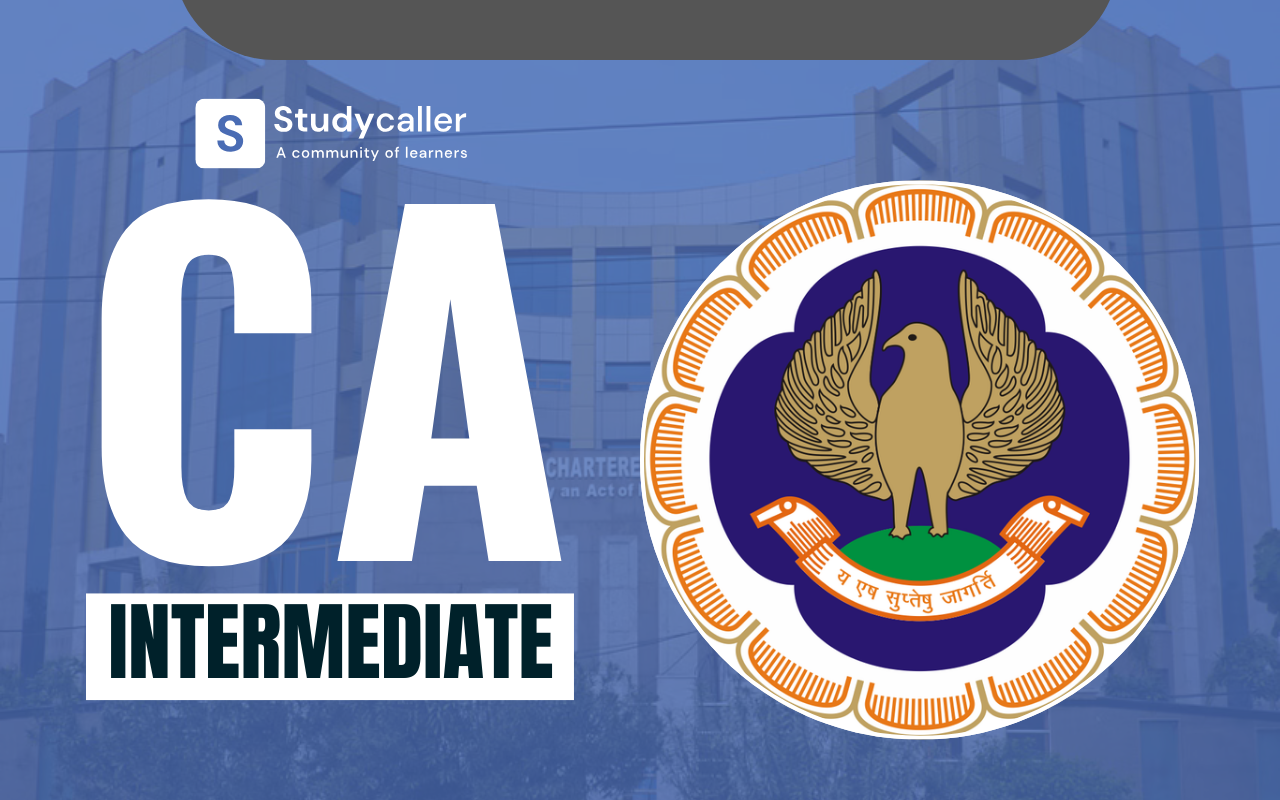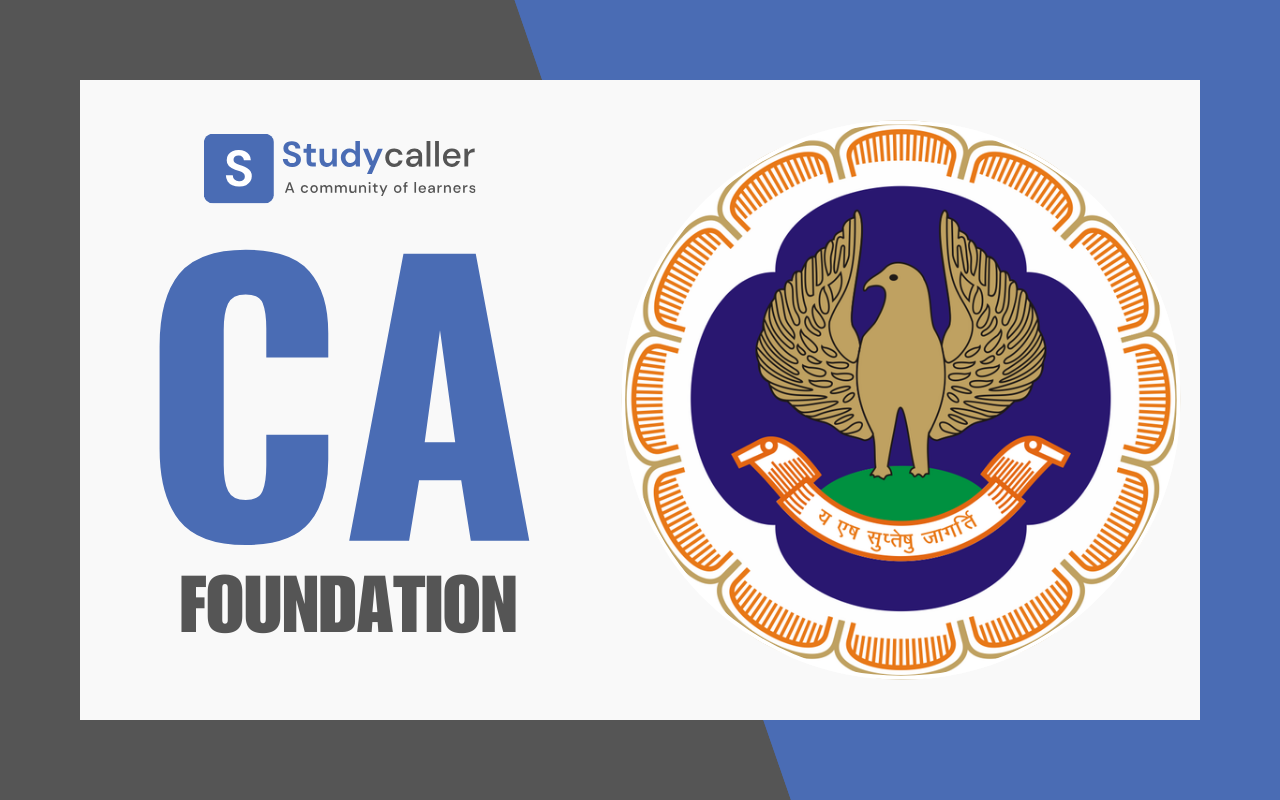CA Foundation Syllabus May 2025 Attempt, Know about Latest ICAI Pattern
CA Foundation Syllabus 2024 Know all subjects, topics, and paper patterns in detail. Stay updated with ICAI’s latest syllabus to crack the exam with confidence.


Table of Content
The ICAI has prescribed the CA Foundation syllabus for May 2025. All subjects about accounting, economics, mathematics, and business law are covered in the CA syllabus 2025 for the Foundation course.
The Institute of Chartered Accountants of India holds the CA Foundation exam. CA Foundation, CA Inter, and CA Final are three levels of the CA course. In order to enable the students to adjust their study patterns, students of CA Foundation must familiarize themselves with the recent exam pattern and syllabus.
The Institute of Chartered Accountants of India (ICAI) specifies the ICAI CA Foundation syllabus. The CA 2025 syllabus for the Foundation course is a detailed covering of all the subjects related to taxation, auditing, and law of business. Candidates have to clear all the CA Foundation papers in order to be able to proceed to the CA Intermediate level.
All levels of exams are difficult, but if compared to one another, the CA Foundation syllabus is the easiest and the CA Final syllabus is the most difficult. There are a total of four papers in the CA Foundation course. Every paper consists of various topics. In this article, you will get to know everything about the CA Foundation syllabus.
Highlights of the CA Foundation Exam Syllabus
The below table provides the candidates with a concise description of the CA Foundation syllabus 2025. According to the current CA Foundation 2025 exam pattern, there are four papers for which candidates must keep their focus during the CA Foundation Sept. 2025 exam preparation. Each of the papers will consist of 100 marks. Details are given in the table below:
| CA Foundation Syllabus 2025 Highlights | |
| Particulars | Details |
| Examination name | CA Foundation exam, earlier known as CA CPT (Common Proficiency Test) |
| Exam-conducting body | The Institute Of Chartered Accountants of India (ICAI) |
| Exam mode | Pen-paper-based or offline |
| Exam frequency | Thrice a year January, May/June, or September |
| Exam Level | National Level |
| Exam difficulty | Easy to moderate |
| Number of paper | 4 |
| Paper names | Paper 1: Principles and Practice of Accounting Paper, 2: Business Laws and Business Correspondence and Reporting, Paper 3: Business Mathematics, Logical Reasoning, and Statistics, Paper 4: Business Economics and Business and Commercial Knowledge |
| Exam duration | 3 hours for Paper 1 and Paper 22 hours for Paper 3 and Paper 4. |
| Maximum marks for each paper | 100 |
| Total marks for all 4 papers | 400 |
| Marking scheme | There will be no negative marking in Papers 1 and 2, as questions will be descriptive. However, ¼ mark will be deducted for every wrong answer in Paper 3 and Paper 4, as questions will be multiple-choice. |
| Medium of exam | English/Hindi except section B for Paper 2 |
Enroll Now for CA Foundation Courses
CA Foundation New Syllabus Paper 2025
The Institute of Chartered Accountants of India (ICAI) released its new syllabus for CA Foundation on 1st July 2023. The first CA Foundation exam after the introduction of the new curriculum will take place in Jan 2025.
| CA Foundation New Syllabus | |||
| Sl. No | Paper Name | Marks | Type of Questions |
| Paper 1 | Accounting | 100 Marks | Objective |
| Paper 2 | Business Laws | 100 Marks | Objective |
| Paper 3 | Quantitative Aptitude: Part A: Business Mathematics Part B: Logical Reasoning Part C: Statistics |
100 Marks Part A: 40 Marks Part B: 20 Marks Part C: 40 Marks |
Subjective |
| Paper 4 | Business Economics | 100 Marks | Subjective |
CA Foundation Syllabus: Paper-Wise 2025
Learn about Principles and Practice of Accounting, Business Laws and Business Correspondence, Business Mathematics and Logical Reasoning, and Statistics, the four papers that make up the 2025 CA Foundation syllabus.
Paper 1: Accounting
To properly construct financial statements and solve simple accounting problems, Paper 1 attempts to assist you in understanding the basic concepts and principles of accounting.
| CA Foundation Syllabus 2025: Principles and Practice of Accounting | |
| Topics | Sub-Topics |
| Theoretical Framework | (i) Meaning and Scope of Accounting (ii) Accounting Concepts, Principles and Conventions (iii) Accounting Terminology—Glossary (iv) Capital and revenue expenditure, Capital and revenue receipts, Contingent assets, and contingent liabilities (v) Accounting Policies (vi) Accounting as a Measurement Discipline—Valuation Principles, Accounting Estimates (vii) Accounting Standards—Concepts and Objectives (viii) Indian Accounting Standards—Concepts and Objectives |
| Accounting Process | (i) Books of Accounts (ii) Preparation of Trial Balance (iii) Rectification of Errors |
| Bank Reconciliation Statement | Introduction, reasons, preparation of bank reconciliation statement |
| Inventories | Cost of inventory, Net realizable value, Basis, and technique of inventory valuation and record keeping |
| Concept and Accounting of Depreciation | Concepts, Methods of computation and accounting treatment of depreciation, Change in depreciation methods |
| Accounting for Special Transactions | (i) Bills of exchange and promissory notes—meaning of bills of exchange and promissory notes and their accounting treatment; accommodation bills. (ii) Sale of goods on an approval or return basis—Meaning of goods sent on an approval or return basis and accounting treatment. (iii) Consignments—Meaning and Features of Consignment Business, Difference Between Sale and Consignment, Accounting Treatments for Consignment Transactions and Events in the Books of Consignor and Consignee. (iv) Average Due Date—Meaning and Calculating of Average Due Date in Various Situations. (v) Account Current—Meaning of Account Current, Methods of preparing Account Current |
| Final Accounts of Sole Proprietors | Elements of financial statements, Closing Adjustment Entries, trading accounts, Profit and loss accounts, and balance sheets of Manufacturing and Non-manufacturing entities |
| Partnership Accounts | (i) Final Accounts of Partnership Firms (ii) Admission, Retirement, and Death of a Partner including Treatment of Goodwill (iii) Introduction to LLPs and Distinction of LLPs from Partnership |
| Financial Statements of Not-for-Profit Organizations | Significance of Receipt and Payment Account, Income and Expenditure Account and Balance Sheet, Difference between Profit and Loss Account and Income and Expenditure Account. Preparation of Receipt and Payment Account, Income and Expenditure Account and Balance Sheet |
| Introduction to Company Accounts | (i) Definition of shares and debentures (ii) Issue of shares and debentures, forfeiture of shares, re-issue of forfeited shares (iii) Statement of Profit and Loss and Balance Sheet as per Schedule III to the Companies Act, 2013. |
Paper 2: Business Law
The Institute of Chartered Accountants of India (ICAI) released its revised syllabus for the CA Foundation course on July 1, 2023. The first CA Foundation exam after the new course will be conducted in Jan 2025.
| CA Foundation Syllabus 2025: Business Laws | ||
| Topics | Laws Covered | Key Points |
| Indian Regulatory Framework | ||
| The Indian Contract Act, 1872 | General Nature of the Contract | Overview of contract basics |
| Consideration | Understanding what makes a contract valid | |
| Other essential elements of a valid contract | Elements necessary for a contract to be legally binding | |
| Performance of a contract | How contracts are fulfilled and obligations met | |
| Breach of contract | What happens when one party fails to uphold their end of the contract | |
| Contingent and Quasi Contract | Special types of contracts with unique characteristics | |
| The Sale of Goods Act, 1930 | Formation of the contract of sale | How contracts for the sale of goods are created |
| Conditions and Warranties | Types of assurances and guarantees in sale contracts | |
| Transfer of ownership and delivery of goods | The process of transferring ownership and delivering goods in a sale | |
| Unpaid seller and his rights | Rights and remedies available to sellers in case of non-payment by the buyer | |
| The Indian Partnership Act, 1932 | General Nature of Partnership | Basics of forming and operating a partnership business |
| Rights and duties of partners | Responsibilities and entitlements of partners in a partnership | |
| Reconstitution of firms | Changes that can occur within a partnership, such as the admission or retirement of partners | |
| Registration and dissolution of a firm | The process of registering and dissolving a partnership firm | |
| The Limited Liability Partnership Act, 2008 | Introduction (Nature and Scope) | Understanding the concept and scope of Limited Liability Partnerships (LLPs) |
| Essential features | Key characteristics that distinguish LLPs from other business structures | |
| Characteristics of LLP | Specific traits and advantages of LLPs | |
| Incorporation and differences with other forms | How to establish an LLP and how it differs from other types of organizations | |
| The Companies Act, 2013 | Essential features of a company | Fundamental aspects of a company, such as legal personality |
| Corporate veil theory | The concept of separating a company’s legal identity from its members | |
| Classes of companies | Different categories of companies based on size and ownership | |
| Types of share capital | Variations in company’s share capital structures | |
| Incorporation of a company | Process of registering and creating a company | |
| Memorandum of Association | A document outlining the company’s constitution and powers | |
| Articles of Association | Regulations governing a company’s internal affairs | |
| Doctrine of Indoor Management | The principle that protects outsiders dealing with a company based on internal authority | |
| The Negotiable Instruments Act, 1881 | ||
Paper 3: Quantitative Aptitude
The third paper of the CA Foundation course is Quantitative Aptitude. Paper 3, Quantitative Aptitude, contains three sections: Business Mathematics, Logical Reasoning, and Statistics. This topic will enable you to verify your calculation skills to do better in higher levels of the CA course.
Part A: Business Mathematics
| CA Foundation Syllabus 2025: Business Mathematics, Logical Reasoning and Statistics | |
| Part: A. Business Mathematics | |
| Topics | Sub-Topics |
| Chapter 1: Ratio and Proportion, Indices and Logarithms | Ratio and Proportion (Business Applications Related to Ratio and Proportion), Laws of Indices, Exponents, Logarithms, and Anti Logarithms. |
| Chapter 2: Equations | Simultaneous linear equations up to three variables, Quadratic and Cubic equations in one variable |
| Chapter 3: Linear Inequalities | |
| Chapter 4: Mathematics of Finance | (i) Simple Interest (ii) Compound interest (iii) Depreciation (iv) Effective Rate of Interest (v) Present Value (vi) Net Present Value (vii) Future Value (viii) Perpetuity (ix) Annuities (x) Sinking Funds (xi) Valuation of Bonds (xii) Calculating of EMI (xiii) Calculations of Returns: a) Nominal Rate of Return b) Effective Rate of Return c) Compound Annual growth rate (CAGR) |
| Chapter 5: Permutations and Combinations | Basic concepts of permutations and combinations: introduction, the factorial, permutations, results, circular permutations, permutations with restrictions, and combinations with standard results. |
| Chapter 6: Sequence and Series | Introduction Sequences, Series, Arithmetic and Geometric Progression, Relationship between AM and GM and Sum of n terms of special series |
| Chapter 7: Sets, Relations and Functions | |
| Chapter 8: Basic Applications of Differential and Integral Calculus (Excluding the trigonometric applications), Differential Calculus (B), Integral Calculus | |
Part B: Logical Reasoning (20 Marks)
Several logical thinking concepts that frequently come up in competitive exams will be covered in this section. Among these subjects are:
| Chapters | Topics |
| Chapter 9 | Number Series, Coding and Decoding, and Odd Man Out |
| Chapter 10 | Direction Tests |
| Chapter 11 | Seating Arrangements |
| Chapters 12 | Blood Relations |
Part C: Statistics (40 Marks)
| Topics | Sub-Topics |
| Chapter 13: Statistical Representation of Data | Diagrammatic representation of data Frequency distribution Graphical representation of frequency distribution—histogram, Frequency Polygon, Ogive, Pie chart |
| Chapter 14: Measures of Central Tendency and Dispersion | Median, Mode Mean Deviation Quartiles and Quartile Deviation Standard Deviation Coefficient of Variation Coefficient of Quartile Deviation. |
| Chapter 15: Probability | Independent and dependent events; mutually exclusive events and compound probability and mathematical expectation. |
| Chapter 16: Theoretical Distributions | Binomial Distribution Poisson distribution—basic application and normal distribution—basic applications |
| Chapter 17: Correlation and Regression | Correlation and Regression: Scatter diagram Karl Pearson’s Coefficient of Correlation Rank Correlation Probable Error and Probable limits Regression lines, Regression equations, Regression coefficients |
| Chapter 18: Index Numbers | Uses of Index Numbers Problems involved in the construction of Index Numbers Methods of construction of Index Numbers |
Paper 4: Business Economics
In Paper 4 of the CA Foundation exam, we are studying business economics. The prime aim here is to make you understand the essential concepts and theories in business economics and know how to apply them to solve real-life problems.
| Topics | Sub-Topics |
| Chapter 1: Nature & Scope of Business Economics | (i) Meaning and scope of Business Economics (ii) Basic Problems of an Economy and Role of Price Mechanism. |
| Chapter 2: Theory of Demand and Supply | (i) Meaning and determinants of demand, Law of demand, and Elasticity of demand—price, income, and cross elasticity (ii) Theory of consumer behavior—Marshallian approach and Indifference curve approach (iii) Meaning and determinants of supply, law of supply, and elasticity of supply. (iv) Demand Forecasting |
| Chapter 3: Theory of Production and Cost | (i) Meaning and Factors of Production (ii) Laws of Production—The Law of Variable proportions and Laws of Returns to Scale, Producer’s equilibrium (iii) Concepts of Costs—Short-run and long-run costs, average and marginal costs, total, fixed, and variable costs. |
| Chapter 4: Price Determination in Different Markets | (i) Various forms of markets—perfect competition, Monopoly, Monopolistic Competition, and Oligopoly (ii) Price determination in these markets |
| Chapter 5: Business Cycles | (i) Meaning (ii) Phases (iii) Features (iv) Causes behind these Cycles |
| Chapter 6: Determination of National Income | (i) National Income Accounting (ii) The Keynesian Theory of Determination of National Income |
| Chapter 7: Public Finance | (i) Fiscal Functions: An Overview, Centre and State Finance (ii) Market Failure/Government intervention to correct Market Failure The Process of Budget Making: Sources of Revenue, Expenditure Management and Management of Public Debt Fiscal Policy |
| Chapter 8: Money Market | The Concept of Money Demand: Important Theories The Concept of Money Supply Monetary Policy |
| Chapter 9: International Trade | Theories of International Trade The Instruments of Trade Policy Trade Negotiations Exchange Rate and Its Economic Effects International Capital Movements |
| Chapter 10: Indian Economy | – |
CA Foundation Syllabus Preparation Tips May 2025
The following are the guidelines to prepare for the CA Foundation Syllabus 2025:
- Know the Syllabus: Familiarize yourself with the CA Foundation syllabus. Go deeper into each subject to know what is included and what is excluded. This enables you to concentrate your study efforts accordingly.
- Start Early: Don't delay! Start preparing for CA Foundation exams as early as possible. Starting early provides you with plenty of time for extensive revision and practice.
- Use Proper Study Material: Make use of study material supplied by ICAI on their official website. It's specially made for the exam. Apart from that, take help from genuine books to improve your hold over CA Foundation subject matters.
- Practice Through Mock Tests: Utilize mock tests to practice in the actual exam scenario. ICAI provides mock tests on their official website, allowing you to assess your preparedness and better your performance.
Summary
You may have been motivated by the success of a chartered accountant, and for that reason, you are opting to acquire the knowledge of CA-Foundation subjects.
It should be noted that he did not arrive there by magic but through sheer hard work, sacrifice, and determination. He determined to give it his best shot, which earned him the title. With five years of hard work, you could be where he is now!
FAQs
What is the CA Foundation syllabus?
Four papers—Principles and Practice of Accounting, Business Laws, Quantitative Aptitude, and Business Economics—that assess knowledge, abilities, and aptitude in various domains make up the CA Foundation syllabus for the May 2025 exam.
Can I pass CA Foundation in 15 days?
Although attempting to pass the CA Foundation within 15 days is extremely difficult and improbable without prior preparation, it is possible to correct and pass possibly if you have a good base and commit to intense, concentrated study
Is CA Foundation account difficult?
CA Foundation accounts paper is tough given the amount of material and necessity for strong conceptual knowledge, but it's also the easiest among the three CA levels, and success is contingent upon committed preparation and a good study plan.
Can I do CA without maths?
Yes, you can pursue a CA course even though you might not have studied mathematics in 11th and 12th standards since there's no compulsory requirement at that stage to be eligible for the CA course.
What are CA course fees?
The overall fee of the CA course (Foundation, Intermediate, and Final) is around ₹3-4 lakhs, out of which Foundation costs ₹11,300, Intermediate (both groups) costs ₹34,200, Intermediate (single group) costs ₹28,000, and Final (both groups) costs ₹39,800.
How to prepare for CA Foundation 2025?
To prepare effectively for the CA Foundation 2025 exam, begin with adequate knowledge of the syllabus, develop a systematic study plan, use ICAI study guides and practice exams, and continuously update your knowledge.
How many hours study for CA Foundation?
For the preparation of the CA Foundation, target at least 6-8 hours of concentrated study every day, particularly the last few months of the exam, to go through the syllabus and practice adequately.
How many students pass the CA Foundation every year?
In the CA Foundation examinations, the pass percentage is normally between 18% and 23%, while in January 2025, the aggregate pass percentage was 21.52%, wherein 23,861 students passed out of 110,887 who appeared.
Is CA a stressful job?
Yes, the heavy workloads, long hours, and pressure to meet deadlines and high expectations may make the CA profession a stressful one. If not handled appropriately, this can result in burnout.
What is CA pass percentage?
The Institute of Chartered Accountants of India (ICAI) CA Final November 2024 results announced a 13.44% aggregate pass percentage. Group I had a pass percentage of 16.8%, and Group II had a pass percentage of 21.36%.








